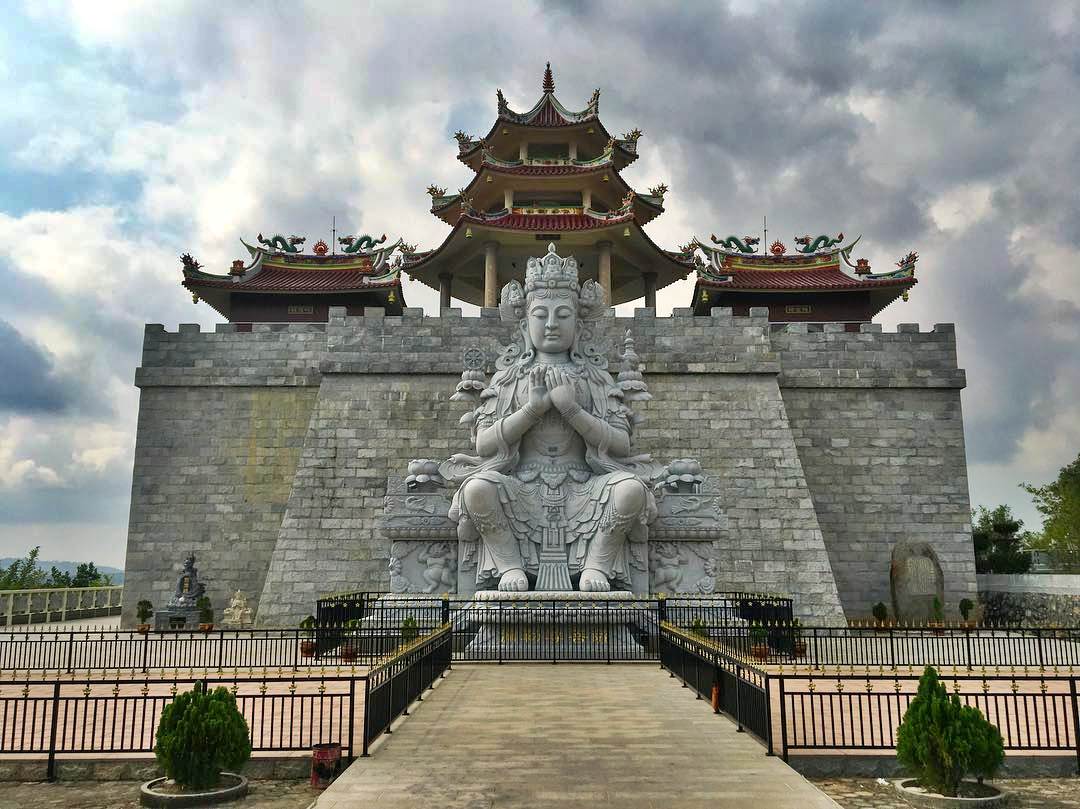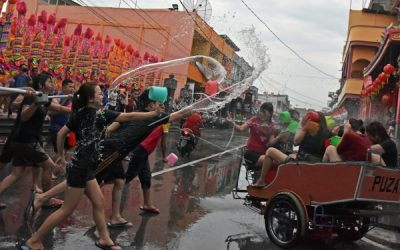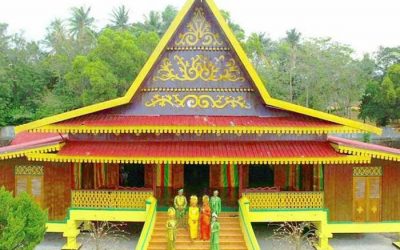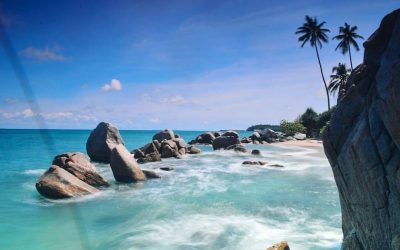Home / Batik Regions – Western Indonesia – Northern Sumatra – Riau Islands / Ksitigarbha Buddhist Shrine
Cultural Destination
Embrace the spirit of the place!
Ksitigarbha Buddhist Shrine
The Bodhisattva Ksitigarbha is known as the Buddhist shrine with a thousand faces. When you sneak peak to the inside part of the temple, there are 500 statues of Lohan with various faces and more than 40 human-like god statues carved based on Buddhist beliefs. The Bodhisattva Ksitigarbha Temple exists as one of the largest Buddhists temples in Southeast Asia after China. It is also regarded as a religious tourism destination in Tanjung Pinang City and Riau Islands Province.
Tourist Attractions in Riau Islands
Cian Cui Festival
Cian Cui Festival is originally an annual tradition of the Chinese descendants in
Daik Lingga Royal Palace
The wonder of the Riau – Lingga royal palace complex consists of
Bintan Trikora Beach
If you want to see a stunning view of granite beach, this place offers a great
Riau Islands
Batik Motifs
Ikan tambal
The word “Ikan” refers to fish. The philosophical meaning of Ikan Tambal means is
Gonggong Siput
Gonggong (Strombus Turturella) is one type of sea snail found around
Tikar Natuna
The Tikar Natuna motif is adapted from the traditional making of pandanus mats in
Gonggong Beruntun
This motif illustrates that a person should maintain a positive attitude and
Discover
Indonesian
Batik
Motifs
Mahkota Siger
Siger is the crown of a noblewoman in ancient time. It is a symbol of femininity, strength, and
Bomba Mawar
This motif means sacred love for family, kingdom, and God; It also illustrates
Gajah Way Kambas
The motif illustrates the Lampung’s natural reserve, the Way Kambas. it also symbolizes
Daun Simpor
This motif is inspired by the Simpor plant (Dillenia Suffruticosa) which is a typical
Prada Papua
The word “Prada” in the Javanese-Indonesian dialect means a batik textile that
Gentala Arasy
Built as high as 80 meters, the tower also highlights the historical side of
Rangkiang
The word “Rangkiang” refers to the rice granary in the Minangkabau language. It symbolizes
Pinawetengan
The Pinawetengan Batik pattern was taken from a prehistoric inscription in
Dayak Taghol
Dayak Taghol has a distinctive style of four curved lines and small dots. This motif represents
Ukir Sentani
The Ukir motif is a batik motif that is inspired by various traditional Sentani wood carvings
Singayaksa
The Singayaksa motif comes from the name of a place where Sultan Hasanuddin used to
Sandeq
Sandeq Boat is a symbol of the maritime importance of the West Sulawesi region. The greatness of
Keluak Daun Pakis
The word “Keluak” is a Minang language which means twisted or tangled. The Motif of
Leuit Sijimat
This motif reflects the daily activities of the Baduy tribe in Banten. The main ornaments of batik motif consist of:
Insang Ikan
Insang refers to the gills of the fish. This is a typical pattern of Malay ethnic who inhabits
Pala Salawaku
This motif illustrates the unique weapons of the Maluku region, namely
Tengkawang Ampiek
With its many advantages, the Dayaks use this leaf in ritual ceremonies. This plant is a symbol of
Lok Baintan Floating Market
As you can imagine, the most authentic thing is that you can buy things and even
Bultiya
The word ‘Bultiya’ is an acronym of the three major tribes in North Kalimantan, namely
Teguh Bersatu
This batik motif shows the strength of the people of Kupang. It also represents a sense of
Daun Lada Hitam
The black pepper motif represents the main commodity of Bangka Belitung
Malinau Cultural Festival
You will witness a unique competition that might not be found other than in
Awan Berarak
Awan Berarak is a combination of Dayak motifs and Malay patterns. The word ‘Awan Berarak’ means the
Sekomandi
Its philosophical meaning is the eternal union which refers to a saying “until death do us part”
Kaharingan
The Kaharingan or ‘tree of life’ based on the Dayak tribes’ belief system. This tree symbolizes
Cengkeh
The clove flower motif is the main commodity of the Tolitoli Regency. This motif represents
Kasih Tak Sampai
‘Kasih Tak Sampai’ is an idiom in the Indonesian language which refers to
Burung Bidadari
Bidadari birds are endemic birds in Halmahera. This motif represents an
Buketan Bali
The Balinese bouquet (Buketan Bali) is a floral arrangement and the name is
Gumin Tambun
Based on Hindu mythology, this motif symbolizes lucks, abundant wealth, and
Kawung
The Kawung motif was created by Sultan Agung Hanyokrokusumo (1593 – 1645) as a symbolic gift for
Gedhog Kembang Waluh
a combination of Javanese cultural motif of the Majapahit kingdom (XII-XIV century) with
Tongkonan
Toraja’s traditional house is called Tongkonan. Tongkonan is a place for
Daun Sirih
This motif illustrates betel leaves that are used by Lombok communities as traditional
Hiu Taliyasan
Indonesia is also home to the world’s largest fish, the whale shark (Rhincodon typus). Hiu Taliyasan refers to
Gamolan
This motif illustrates Gamolan, a bamboo musical instrument of Lampung that is
Karawo Pinang
Pinang refers to the Palm areca tree. This motif is considered as the original
Pattimura
Pattimura is the name of an Indonesian hero who fought against colonialism in
Ake Patra
Ake is related to the divinity and the composition of the universe. It is a symbol of
Enggang Dayak
Local people beliefs that hornbills are an incarnation of the Commander of the Birds. It has supernatural
Honai
The Honai is inspired by the traditional house of the Papuan community living in
Tenun Bima
The motifs are adopted from Bima woven textile. This pattern has received a great
Pati-Pati Pinehiku
It symbolizes the hierarchy in society and the social status of the Mekongga
Taiganja
Taiganja is a precious gold pendant that shows the social status of the Kaili family. It is
Gorga Simeol-Meol
The Gorga Simeol-meol is a pattern of plant tendrils. it is regarded as a symbol of longevity and
Dayak Kamang
Kamang motif is generally found in the Dayak tribe shield because it is believed to
Jumputan Bintang
The word Jumputan means the tie-dye technique, while the word “Bintang” refers to
Pohon Hayat (Tree of Life)
The Batik motifs in Lampung are dominated by the acculturation of Buddhist and
Parang Rusak
Another meaning behind this motif is an unconquerable spirit, symbolized by
Bintik Tujuh
The Bintik Tujuh (Seven Dots) motif has 7 white spots and green color gradation as
Tangerang Herang
Tangerang Herang motif is a symbol of Tangerang city. The Tangerang Herang batik motif consists of
Angsa Duo
According to legend, the Angso duo batik motif is a pair of swans that are believed to have led Princess
La Galigo
La Galigo is a literary work of the Buginese Epic that has 300 thousand epic lines. It is considered even
Kerawang Tegak Aceh
The Vertical Upright (Kerawang Tegak) Motif symbolizes a person who has a strong
Tabir Tanjung
Tanjung flower is a type of Cherry tree flower, which is commonly found in
Tampuk Manggis Sasirangan
The motif illustrates the philosophy of the mangosteen fruit, which is
Srimanganti
The name of the Srimanganti motif is derived from Palace’s hallway that connects to
Tubo Kelapa
Coconut tree is a symbol of a good character and strong mentality. It illustrates the more success a person, the more
Karawo Mahkuta
Mahkuta refers to Gorontalo’s traditional crown. It represents noble characters of
Parang Seling
Parang Seling or “alternating daggers” is a royal batik motif. It is a feminine variant of
Tifa Totobuang
The batik motifs illustrate Maluku’s traditional music instrument called
Biji Kopi
The coffee seeds motif illustrates the pride of local coffee specialities in
Wakatobi
It symbolizes the coastal beauty of the Wakatobi island and the symbol of Patra symbolizes
Paqbarre Allo
The word “Barre” means round and “Allo” means the sunlight. This motif is interpreted as
Gigi Haruan Lidi
The Gigi Haruan Lidi motif is taken from the name of the cork fish and is a symbol of
Gonggong Beruntun
This motif illustrates that a person should maintain a positive attitude and
Besurek Rafflesia
The term “Basurek” refers to a textile that contains letters or inscriptions
Gurdo Solo
Gurdo or garuda bird is the mount of the Indian god Vishnu. As the Sun Bird,
Kain Cual
Cual textile tradition has existed since the 17th century. The word “Cual” refers to
Tikar Natuna
The Tikar Natuna motif is adapted from the traditional making of pandanus mats in
Ikan tambal
The word “Ikan” refers to fish. The philosophical meaning of Ikan Tambal means is
Pucuk Rebung Riau
Pucuk Rebung symbolizes heart determination in achieving goals, good luck, and
Kaganga Tanah Rejang
If Batik Besurek combines Arabic calligraphy motifs, then the Kaganga batik takes






